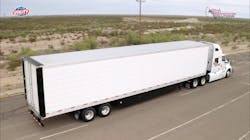Utility Trailer publishes third-party fuel economy test results for its aero tech
Fuel economy tests conducted by MVT Solutions on Utility Trailer Manufacturing Co.’s standard Aerodynamic Side Skirt (USS-120A-4) and the optional Aerodynamic Tail (UAT) showed that, when combined, the devices deliver fuel savings of 646 gallons of fuel per 100,000 miles.
“Over the years we have conducted several rigorous tests at our state-of-the-art R&D facility, but a third-party fuel economy test for our aerodynamic devices provides us with calculations that validate our own,” said Craig Bennett, senior vice president, sales and marketing, Utility. “Utility’s customers can see that the impact on profitability can be significant when equipping both the side skirt and aerodynamic tail. Compared to other trailer tails, the UAT is lighter in weight and is a low-cost option, and has the advantage of being installed by the OEM, and having a 5-year factory warranty.”
Utility’s USS-120A-4 Aerodynamic Side Skirt is a standard feature on both the 3000R refrigerated van and the 4000D-X Composite dry van trailers. The Utility Aerodynamic Tail is an option on dry vans and reefers. The side skirt is built with UV-protected bi-directional fiberglass reinforced plastic to extend skirt life. Utility’s aerodynamic tail weighs approximately 25 pounds and is made of a UV-protected thermoplastic composite that is comprised of two full-height side fairings and one full-width roof fairing.
“Fuel economy is the easiest and fastest way to increase your bottom line. We believe that the USS and the UAT, when used together, will generate the best ROI in the aerodynamic segment of the industry,” Bennett said. “Additionally, based on the positive test results from MVT Solutions, we developed a fuel savings calculator on Utility’s website to give fleets an idea of how much they could potentially save by using our aerodynamic products.”
MVT Solutions was formed in 2016 and is based in Las Cruces, New Mexico. MVT Solutions is a third-party provider of fuel economy testing, consulting and real-world analysis for the trucking industry. The company conducts fuel economy testing based on racecar engineering. This method of high-tech testing can obtain accuracy up to .25 percent and accounts for such variables as wind, climate, load, driver behavior, and duty cycle, Utility noted.
